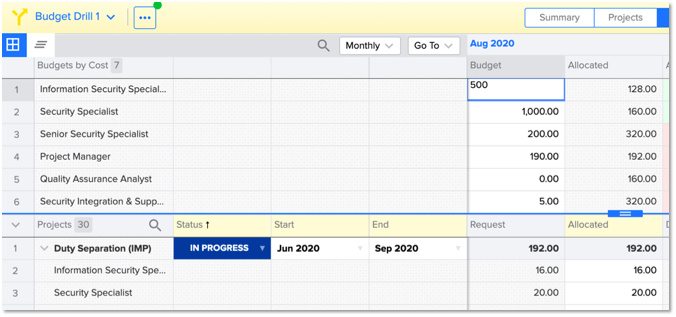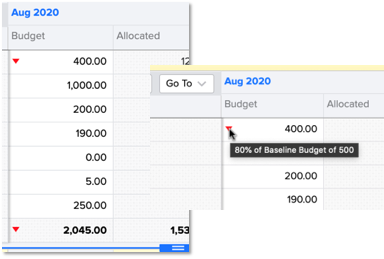What-if Plans are designed to be able to explore different courses of action deviating from the baseline and to analyze the differences. Until now, the variables that are able to be adjusted in a What-if plan are:
- Project Status
- Project Start
- Project End
- Project Allocation
Budgets were considered “Portfolio Level” data and thus were the same across all plans, Baseline and What-ifs.
Purposes of Budgets in What-If Plans
They can be used to model different level of potential Budgets both for increases and decreases and having the recommendation engines be able to suggest optimizations based on different Budget scenarios becomes a powerful new capability.
Editing Budgets
When a What-if plan is created Budgets in the upper table will be editable as with the other variables in a What-if (Status, Start, End, and Allocation)

When the Budgets of a What-if plan are updated, arrows will display to indicate if the Budget is higher or lower than the baseline
- Red Arrow = lower budget than baseline
- Green Arrow – higher budget than baseline
Total Budget for the time period will also display the indicator and Yearly Totals will also display arrows where applicable with Monthly changes. Hovering over the arrow will display the details of the difference from baseline.

Recommendations within What-If Plans
The Recommendation Engines for Bottleneck Analysis and Strategy Navigator will continue to be accessible in What-if Plans
Recommendations will be suggested based on the assumption of the new budget amounts
Grading and Comparison Implications
In the Strategy Navigator, while the recommendations will align with Budgets in the What-if plan, the grading in the Recommendation Rationale will be based on the Budgets set in the Baseline
With different Budget amounts in different What-ifs, there will be different ”universes” of possible plans
While these unique universes can be leveraged for recommendations, for comparison purposes, there must be an apples to apples standardization, as such, the grading is based on the universe as defined in the Baseline
For example, in a What-if plan that has additional budget above the Baseline, grades will be calculated based on the Baseline so using additional budget could have positive impacts on Value, Risk, or Balance while making a Cost grade worse by going further beyond Baseline budgets (even if within tolerances for the What-if Budgets). In some unique use cases, it is possible for the recommendations to result in a seemingly worse overall grade in the Strategy Navigator
In Comparison Views, the Grading will all be based off the universe as defined by the Baseline Budget
Rebaselining
When the Baseline is updated for a What-if plan, not only will the Project specific changes be updated in the new Baseline but also Budget data as defined in the What-if where applicable
Important Note: If the Budgets in the What-if differ from the Baseline, Plan Grades seen in the Summary may be slightly different than seen in Comparison once the Baseline Update is completed. This is due to Comparison Grading being based on the previous Baseline.
Once rebaselined, the “standard universe” being used for the comparison grading is now the Based on the new data from the rebaseliened What-if